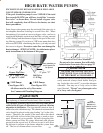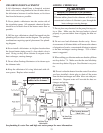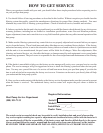
22
TOTAL ALKALINITY
Total Alkalinity is a test given to determine the over-
all mineral content of the water. Total alkalinity lev-
els should be within the range from 90 p.p.m. to 120
p.p.m. The total alkalinity is described as a buffer
against acetic conditions and acts as a stabilizer for the
pH. It keeps the pH from fluctuating up and down.
A low alkalinity will allow the pH to fluctuate, usually
to the acetic side. A high alkalinity may cloud the wa-
ter. The pH of your water will change when it is used
after rain, from dirt and debris and many other natural
conditions. The proper total alkalinity will prevent
those changes from being drastic. Test for total alka-
linity on a weekly basis.
CALCIUM HARDNESS
Calcium Hardness levels should remain within the
range from 250 p.p.m. to 400 p.p.m. Calcium hardness
is a test that determines the saturation levels of calcium
and magnesium salts in the water. This tells you in lay-
man terms how “hard” the water is. Please refer to your
pool builders instructions concerning calcium hardness
and how it effects your particular pool surfacing mate-
rial.
POOL CHEMICAL & CHLORINATOR USE
When you are adding pool chemicals as part of your regular maintenance there are several rules of thumb to
follow. Where you add the chemicals are just as important as how much you add. This section will discuss the
“do’s and don’ts" of where you add chemicals or where chlorinators are placed.
VACUUM LEAKS
Suction leaks that allow air into the system when the
pump is running will cause damage to the heat ex-
changer. Suction leaks are what cause the system to
back siphon or reverse flow. Make sure that all the o-
ring seals in the pump lid, filter and chlorinator are in
good condition and are lubricated with silicone grease.
If your filter repeatedly has excessive air inside it when
you open, air the bleed valve, you may have a vacuum
leak. Vacuum leaks that allow an accumulation of air in
the filter and will cause the system to lose prime when
the pump is off and allow reverse flow. Reverse flow
may allow chlorine solution to migrate to the heat ex-
changer.
Vacuum leaks will cause premature wear to the heat ex-
changer. The air allowed into the system causes turbu-
lence in the heat exchanger. The result is physical ero-
sion to the metal alloy water channel.
Note: Chlorine solution is heavier than water and
will migrate through the plumbing even if there is
no vacuum leak.
PROTECT HEAT EXCHANGER
You want to prevent any chemicals from running through
the piping and heat exchanger of the unit. Chlorine so-
lution will damage the heat exchanger. Some chlori-
nating devices inject chlorine solution through the suc-
tion side of the filtering system, thus the chlorine passes
through the heat exchanger at full strength before it has
a chance to mix and dilute with the rest of the pool wa-
ter. Also note: The overall chemical balance of the pool
water will directly effect the life of the heat exchanger.
CHLORINE MIGRATION
Some chlorinating devices will back siphon when the
system is shut off, therefore allowing the chlorine solu-
tion to migrate through the heat exchanger causing dam-
age. You have to make sure your filtering system does
not have a vacuum leak that would allow the system to
lose prime. When this happens, water will move back-
wards through the chlorinator thus moving the chlorine
solution into the heat exchanger. Note: Chlorine solu-
tion is heavier than water and will migrate through the
plumbing even if there is no vacuum leak.


















